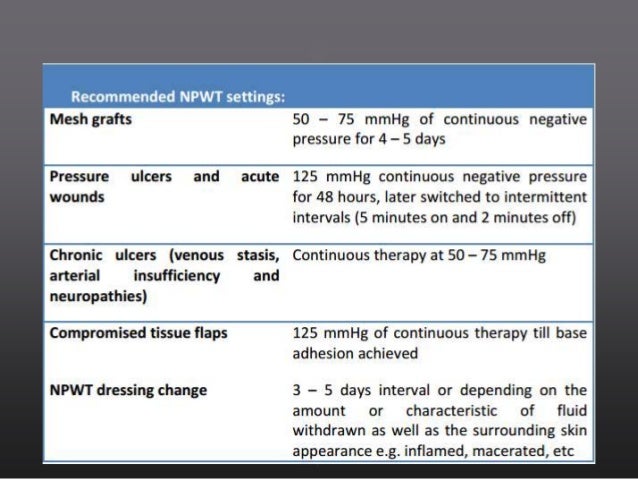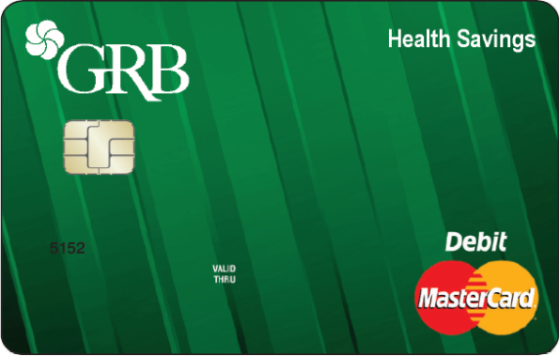Negative Pressure Settings The units are set in millimeters of mercury mmHg and the surgeon who placed the device will generally set the suction parameters. Chronic partial-thickness burns pressure ulcers acute dehisced wounds flaps traumatic diabetic ulcers grafts.
 Negative Pressure Wound Therapy Npwt
Negative Pressure Wound Therapy Npwt
Types of wounds for which VAC Therapy currently has been indicated include.

Wound vac pressure settings. White foam dressing in the wound or in tunneled areas. Variable pressure therapy VPT has therefore been introduced to provide a smooth transition between 2 different pressure environments thereby maintaining the negative pressure environment throughout the. How-ever interpretation of this trial is limited by a high loss to follow-up and lack of a control group treated with dressings.
Consider titrating the VAC. For VAC therapy KCI recommends a pressure setting of -125 mmHg for normal use in the majority of wounds3 This recommendation was based on the original work by Morykwas and colleagues who looked at negative pressures from 0 to -400 mmHg in 25 mmHg increments2 Their model applied NPWT to 25 cm2 artificially created defects down to deep fascia overlying the spine. Basic studies have shown beneficial effects on wound blood flow and proliferation of healing granulation tissue.
The area is sealed with an. Also never remove your wound. With VAC Therapy customers can select continuous or intermittent DYNAMIC PRESSURE CONTROL Therapy Mode application of negative pressure.
VERAFLO Therapy the user can select the appropriate topical wound. NPWT parameters such as negative pressure settings and duration of negative pressure therapy between instillation cycles can also be customized. Components of chronic wound care.
The foam acts as the wound contact material and fills the wound. The default setting is 125mmHg on a continuous suction but settings can be individualized to the patients specific needs. Vacuum-assisted closure is an active wound therapy rather than a wound dressing.
We searched for comparative trials that followed subjects in the home setting. These studies are insufficient to draw conclusions about its efficacy. These settings control how much negative pressure is applied to your wound.
Negative pressure wound therapy NPWT also referred to as vac uum-asssi ted wound closure is a treatment for acute and chronic wounds that uses the controlled application of subatmospheric pressure to the surface of a wound to remove exudate and debris. Theoretically the method acts by removal of excess tissue fluid from the ext. Its also referred to as negative pressure wound therapy.
NPWT dressings that cover skin grafts may have lower settings. Vacuum assisted wound closure VAC is a closed system which applies negative pressure to the wound tissues. Is achieved by measuring the level of negative pressure at the wound site.
An excellent review of Vacuum-Assisted Closure in the lower extremity was. Negative pressure wound therapy NPD using the 7ound VAC Vacuum-Assisted Closure system KCI San Antonio TX has become an importanr rreatment modality for a variety of wounds in numerous medical fields and its indications and popularity have significantly grown in the past few years. Wound management with vacuum therapy.
It is then connected via a suction tube to a canister which fits on the side of the vacuum. Between negative pressure and zero pressure. It is important that you do not change the settings on your VAC Therapy System unless instructed to do so by your doctor or nurse.
We included studies examining the use of NPWT in patients with chronic wounds including venous leg ulcers arterial leg ulcers diabetic foot ulcers pressure ulcers and mixed etiology chronic wounds. The VAC Therapy System is a medical device that promotes wound healing by applying negative pressure a vacuum to your wound. Intermittent pressure therapy IPT results in faster wound healing but it often causes pain.
The devices may also be used as an adjunct to surgical therapy or as an. The system includes dressni gs a suction pump tubing and a coll ection chamber. Pressure non-powered Wound Care System showed noninferiority to a vacuum-assisted closure device.
The majority of wounds will be managed with -125 mmHg of continuous suction. Pressure setting up by 25mmHg increments for excessive drainage large wound volume or VAC. Negative pressure wound therapy NPWT is commonly used in the continuous mode.
Vacuum-assisted closure VAC is a method of decreasing air pressure around a wound to assist the healing. Your wound is covered by a dressing that protects the injured area. Negative pressure wound therapy NPWT involves the use of a negative pressure therapy or suction device to aspirate and remove fluids debris and infectious materials from the wound bed to promote the formation of granulation tissue.
First described by Morykwas and Argenta 1997 the VAC system applies a subatmospheric or negative pressure to the wound bed via an open-cell polyurethane foam dressing. Most wounds are managed with continuous therapy.
